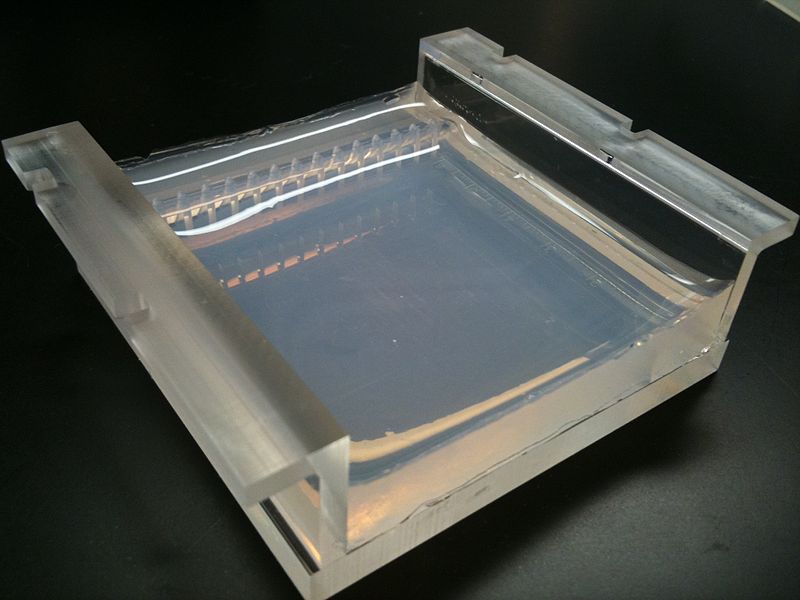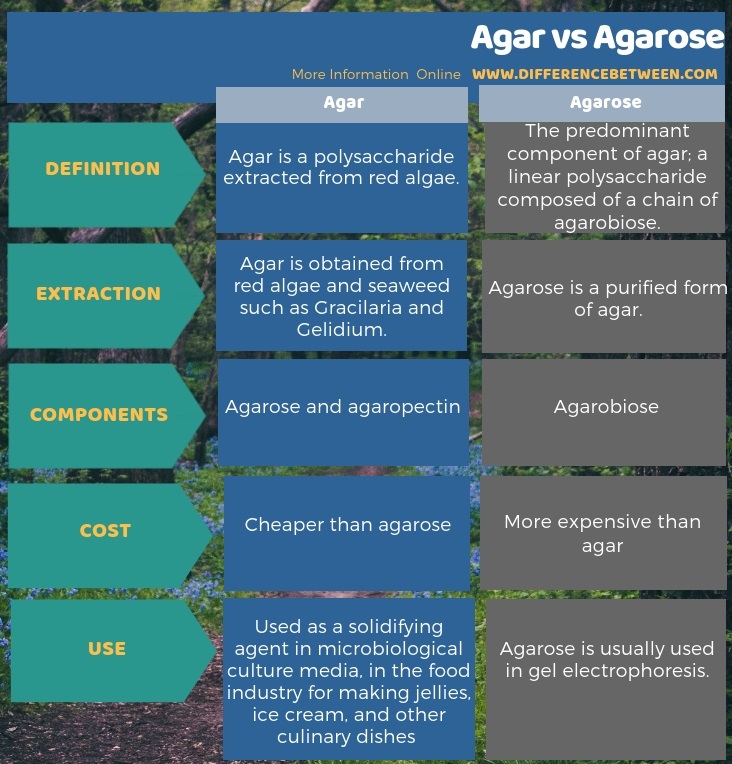Difference Between Agar and Agarose
The key difference between agar and agarose is that the agar is a gelatinous substance obtained from red algae while the agarose is a linear polymer purified from agar or red seaweeds.
Agar and agarose are two kinds of polysaccharide products that come from red algae or seaweed. They are very useful in a variety of fields, ranging from the kitchen, like food, to the chemistry labs, as a culture for bacteria growth. Hence, cultivation of these sources is commercially valuable, and it is carrying out in parts of Asia and the United States. Structurally, agarose is a linear polymer consisting of alternating D-galactose and 3,6-anhydro-L-galactose units. On the other hand, agar is a mixture of agarose and agaropectin.
CONTENTS
1. Overview and Key Difference
2. What is Agar
3. What is Agarose
4. Similarities Between Agar and Agarose
5. Side by Side Comparison – Agar vs Agarose in Tabular Form
6. Summary
What is Agar?
Agar, or agar-agar, is a polysaccharide extracted from red algae such as Gracilaria and Gelidium. It is usually a gelatinous substance. Mainly it serves as an element in the preparation of growth media for culturing bacteria, fungi and other microbes for scientific and medicinal research. Agar contains galactose; a polymer which can also be used as gelatine-like food that vegans can substitute for meat.

Figure 01: Agar
Furthermore, agar contains agaropectin; a heterogeneous mixture of smaller molecules. Among the two components; agarose and agaropectin, agarose accounts for more than 70% of the mixture. Agar melts at about 80 0C while it solidifies below 40 0C. Thus, this feature has made agar into an appropriate solidifying agent in microbiological media.
What is Agarose?
Agarose is a polysaccharide purified from agar or obtained from agar producing red seaweed. It is a linear polymer of agarobiose which is a disaccharide made from D-galactose and 3,6-anhydro-L-galactopyranose.

Figure 02: Agarose
Moreover, agarose is the predominant component of the agar which accounts for more than 70% of it. Agarose is very useful in bacteria culturing. Furthermore, agarose is a useful ingredient in preparing gels for agarose gel electrophoresis to separate DNA. During the gel-electrophoresis, agarose forms a neutral gel matrix which can easily be liquefied in high temperatures but easily reverts in gel form when cooled.
What are the Similarities Between Agar and Agarose?
- Both Agar and agarose are high-molecular-weight polysaccharides extracted from the cell walls of certain marine red algae.
- They are useful as solidifying agents in microbiological and molecular biological studies.
- Also, both solidify at cold temperatures but, melt at high temperatures.
- Agar and agarose are extensively necessary for microbiological studies and for culturing bacteria.
- Besides, both are gelatin-like.
What is the Difference Between Agar and Agarose?
Both Agar and agarose are polysaccharides. Agar comes directly from red algae while we obtain agarose from agar by further purification of agar. Importantly, agarose is the major component of agar. Hence, this is the key difference between agar and agarose. Also, agarose is a linear polysaccharide while agar composed of agarose and agaropectin. Agar production is a less time consuming and less complex process than the agarose production. Furthermore, the common use of agar is in the food industry as ingredients for jellies, ice creams, mizuyokan, and gulaman while the main use of agarose is in the gel electrophoresis. Thus, this is another difference between agar and agarose.
The below comparison chart on difference between agar and agarose summarizes the differences in tabular form.

Summary – Agar vs Agarose
Agar and agarose are two polysaccharides derived from red algae. Structurally, agar contains two components; namely, agarose and agaropectin while agarose contains agarobiose which is a disaccharide. Therefore, this is the key difference between agar and agarose. Furthermore, agar is cheaper than agarose since we obtain agarose from the further purification of agar. The main use of agar is as a solidifying agent in microbiological culture media while the main use of agarose is in the gel electrophoresis.
Reference:
1.“Agarose.” NeuroImage, Academic Press. Available here
Image Courtesy:
1.”Youkan mizuyoukan”By Tarobo ja.wikipedia.org – Own work (CC BY-SA 3.0) via Commons Wikimedia
2.”Two percent Agarose Gel in Borate Buffer cast in a Gel Tray (Front, angled)”By Joseph Elsbernd (CC BY 2.0) via Commons Wikimedia
ncG1vNJzZmivp6x7pbXFn5yrnZ6YsqOx07CcnqZemLyue8OinZ%2Bdopq7pLGMm5ytr5Wau26txpqpZpmemXq3v4yanpqqn6iycA%3D%3D